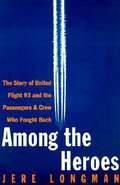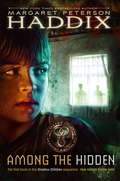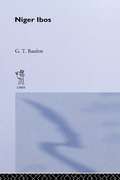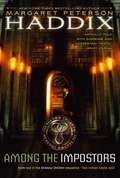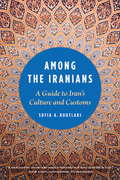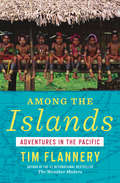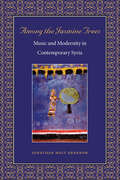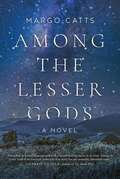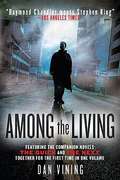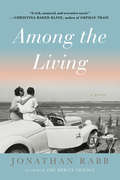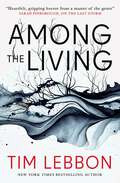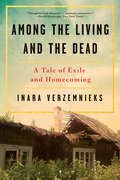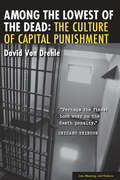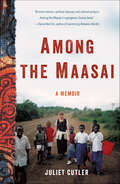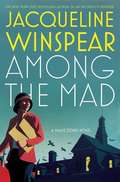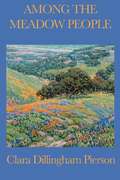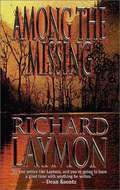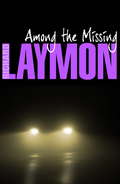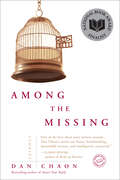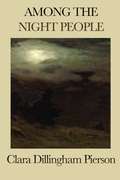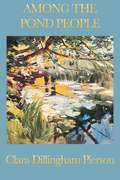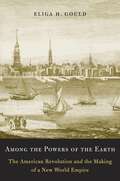- Table View
- List View
Among the Heroes: United Flight 93 & the Passengers & Crew Who Fought Back
by Jere Longman“A powerful reconstruction of the flight’s final moments. . . . Made me think of John Hersey’s Hiroshima.” — New York Times Book ReviewThedefinitive story of the courageous men and women aboard Flight 93 on September 11, 2001, and of the day that forever changed the way Americans view the world and themselves.Of the four horrific hijackings on September 11, Flight 93 resonates as one of epic resistance. At a time when the United States appeared defenseless against an unfamiliar foe, the gallant passengers and crew of Flight 93 provided for many Americans a measure of victory in the midst of unthinkable defeat. Together, they seemingly accomplished what all the security guards and soldiers, military pilots and government officials, could not—they thwarted the terrorists, sacrificing their own lives so that others might live.The culmination of hundreds of interviews with family members and months of investigation,this powerful and deeply moving book is a lasting testament to American heroes.
Among the Heros
by Jerry LongmanON SEPTEMBER 11, 2001, passengers were not encouraged to assist the crew in the rare case of an airplane hijacking. They were actively discouraged. That all changed with the brave insurrection of the passengers and crew members aboard United Flight 93.
Among the Hidden
by Margaret Peterson Haddixâ It is a curse we have lived with, this past century and more, sir,' he said. â That post holds down the ghost of one Peter Christian Holm, one-time administrator of the mill here and the surrounding farms. 'â Holds down the ghost!' I repeated, aghast. â But how? And why?'â Let me tell you the story, sir. Let me take you back into our past. . . '
Among the Hidden (Shadow Children #1)
by Margaret Peterson HaddixIn a future where the Population Police enforce the law limiting a family to only two children, Luke, an illegal third child, has lived all his twelve years in isolation and fear on his family's farm in this start to the Shadow Children series from Margaret Peterson Haddix.Luke has never been to school. He's never had a birthday party, or gone to a friend's house for an overnight. In fact, Luke has never had a friend. Luke is one of the shadow children, a third child forbidden by the Population Police. He's lived his entire life in hiding, and now, with a new housing development replacing the woods next to his family's farm, he is no longer even allowed to go outside. Then, one day Luke sees a girl's face in the window of a house where he knows two other children already live. Finally, he's met a shadow child like himself. Jen is willing to risk everything to come out of the shadows -- does Luke dare to become involved in her dangerous plan? Can he afford not to?
Among the Impostors: Among The Hidden; Among The Impostors; Among The Betrayed; Among The Barons; Among The Brave; Among The Enemy; Among The Free (Shadow Children #2)
by Margaret Peterson HaddixDanger continues to loom over Luke now that he's out of hiding in the second book in bestselling author Margaret Peterson Haddix's Shadow Children series.Luke Garner is an illegal third child. All his life has been spent in hiding. Now, for the first time, Luke is living among others. He has assumed a deceased boy's identity and is attending Hendricks School for Boys, a windowless building with cruel classmates and oblivious teachers. Luke knows he has to blend in, but he lives in constant fear that his behavior will betray him. Then one day Luke discovers a door to the outside. He knows that beyond the walls of Hendricks lie the secrets he is desperate to uncover. What he doesn't know is whom he can trust -- and where the answers to his questions may lead him...
Among the Iranians: A Guide to Iran's Culture and Customs
by Sofia A. KoutlakiAn indispensable practical guide, Among the Iranians offers insight into Iranian dress, etiquette, and food. Koutlaki explains everything readers need to know about culture and customs by sharing lessons she learned as a foreigner living in Tehran. Readers are challenged to dispel previous judgments of Iran and accept Koutlaki's version of the country-warm, inviting, and rich with tradition.
Among the Iranians: A Guide to Iran's Culture and Customs
by Sofia A. KoutlakiThe eyes of the world are on Iran, from nuclear issues to women's rights to Iran's perspective on Palestine. Yet a strictly political view does not allow for an accurate or complete outlook on this important and facinating country. In Among the Iranians, Greek-born author Sofia A. Koutlaki shares the lessons she's learned firsthand as a foreigner living in Tehran. Through memorable anecdotes and in-depth explanations of Iranian customers, Koutlaki presentd a side of Iran that foreigners rarely see. The author's insight challenges readers to dispel their previous notions and judgements to see Iran at its heart--warm, inviting and rich with tradition. Among the Iranians is also an indispensable practical guide, offering insight about Iranian dress, etiquette and even food.
Among the Islands: Adventures in the Pacific
by Tim FlanneryTim Flannery is one of the world’s most influential scientists, credited with discovering more species than Darwin. In Among the Islands Flannery recounts a series of expeditions he made at the dawn of his career to the strange tropical islands of the South Pacific, a great arc stretching nearly 4,000 miles from the postcard perfection of Polynesia to some of the largest, highest, ancient, and most rugged islands on earth. Flannery was traveling in search of rare and undiscovered mammal species, but he found much more: wild, weird places where local taboos, foul weather, dense jungle, and sheer remoteness made for difficult and dramatic exploration. Among the Islands is full of fascinating creatures monkey faced bats, giant fats, gazelle-faced black wallabies, and more and the adventure of discovery. This is an idea read for anyone who has ever imagined voyaging to the ends of the earth to uncover and study the rare and the wonderful.
Among the Jasmine Trees: Music and Modernity in Contemporary Syria (Music Culture)
by Jonathan Holt ShannonHow does a Middle Eastern community create a modern image through its expression of heritage and authenticity? In Among the Jasmine Trees: Music and Modernity in Contemporary Syria, Jonathan H. Shannon investigates expressions of authenticity in Syria's musical culture, which is particularly known for embracing and preserving the Arab musical tradition, and which has seldom been researched in depth by Western scholars. Music plays a key role in the process of self-imaging by virtue of its ability to convey feeling and emotion, and Shannon explores a variety of performance genres, Sufi rituals, song lyrics, melodic modes, and aesthetic criteria. Shannon shows that although the music may evoke the old, the traditional, and the local, these are re-envisioned as signifiers of the modern national profile. A valuable contribution to the study of music and identity and to the ethnomusicology of the modern Middle East, Among the Jasmine Trees details this music and its reception for the first time, offering an original theoretical framework for understanding contemporary Arab culture, music, and society.
Among the Lesser Gods: A Novel
by Margo CattsFor fans of authors like Barbara Kingsolver and Leif Enger, a stunning new voice in contemporary literary fiction."Tragedy and blessing. Leave them alone long enough, and it gets real hard to tell them apart." Elena Alvarez is living a cursed life. From the deadly fire she accidentally set as a child, to her mother's abandonment, and now to an unwanted pregnancy, she knows better than most that small actions can have terrible consequences. Driven to the high mountains surrounding Leadville, Colorado by her latest bad decision, she's intent on putting off the future. Perhaps there she can just hide in her grandmother's isolated cabin and wait for something–anything–to make her next choice for her. But instead of escape, she finds reminders of her own troubles reflected from every side–the recent widower and his two children adrift in a changed world, Elena's own mysterious family history, and the interwoven lives within the town itself. Bit by bit, Elena begins to reconsider her role in the tragedies she's held on to and the wounds she's refused to let heal. But then, in a single afternoon, when threads of cause and effect tangle, Elena's fragile new peace is torn apart. It's only at the prospect of fresh loss and blame that she will discover the truth of the terrible burdens we take upon ourselves, the way tragedy and redemption are inevitably bound together–and how curses can sometimes lead to blessings, however disguised.
Among the Living
by Dan ViningTwo novels in one trade volume. There are so many mysteries hidden in the fog off the Pacific Coast. Jimmy Miles has been hired to solve them. But they?re not the only things keeping him up at night... In The Quick, an investigation into a long-ago murder leads to his discovery of the Sailors?restless strangers who roam the night, trapped between the world of the living and dead. In The Next, still haunted by the Sailors, Jimmy becomes obsessed with a sudden rash of murders, and a never-forgotten love affair that may hold the clue to his future.
Among the Living
by Jonathan RabbA moving novel about a Holocaust survivor's unconventional journey back to a new normal in 1940s Savannah, Georgia. In late summer 1947, thirty-one-year-old Yitzhak Goldah, a camp survivor, arrives in Savannah to live with his only remaining relatives. They are Abe and Pearl Jesler, older, childless, and an integral part of the thriving Jewish community that has been in Georgia since the founding of the colony. There, Yitzhak discovers a fractured world, where Reform and Conservative Jews live separate lives--distinctions, to him, that are meaningless given what he has been through. He further complicates things when, much to the Jeslers' dismay, he falls in love with Eva, a young widow within the Reform community. When a woman from Yitzhak's past suddenly appears--one who is even more shattered than he is--Yitzhak must choose between a dark and tortured familiarity and the promise of a bright new life. Set amid the backdrop of America's postwar south, Among the Living grapples with questions of identity and belonging, and steps beyond the Jewish experience as it situates Yitzhak's story during the last gasp of the Jim Crow era. Yitzhak begins to find echoes of his own experience in the lives of the black family who work for the Jeslers--an affinity he does not share with the Jeslers themselves. This realization both surprises and convinces Yitzhak that his choices are not as clear-cut as he might have thought.
Among the Living
by Tim LebbonFrom the New York Times bestseller and author of Netflix&’s The Silence comes a terrifying horror novel set in a melting Arctic landscape. Something deadly has lain dormant for thousands of years, but now the permafrost is giving up its secrets…Estranged friends Dean and Bethan meet after five years apart when they are drawn to a network of caves on a remote Arctic island. Bethan and her friends are environmental activists, determined to protect the land. But Dean&’s group's exploitation of rare earth minerals deep in the caves unleashes an horrific contagion that has rested frozen and undisturbed for many millennia. Fleeing the terrors emerging from the caves, Dean and Bethan and their rival teams undertake a perilous journey on foot across an unpredictable and volatile landscape. The ex-friends must learn to work together again if they&’re to survive... and more importantly, stop the horror from spreading to the wider world.A propulsive horror thriller––fast-moving, frightening, and shockingly relevant—this adventure will grip you until the final terrifying page.
Among the Living and the Dead: A Tale Of Exile And Homecoming On The War Roads Of Europe
by Inara Verzemnieks“Extraordinarily tender and finely wrought.” — Eliza Griswold, author of The Tenth Parallel “It’s long been assumed of the region where my grandmother was born…that at some point each year the dead will come home,” Inara Verzemnieks writes in this exquisite story of war, exile, and reconnection. Her grandmother’s stories recalled one true home: the family farm left behind in Latvia, where, during WWII, her grandmother Livija and her grandmother’s sister, Ausma, were separated. They would not see each other again for more than 50 years. Raised by her grandparents in Washington State, Inara grew up among expatriates, scattering smuggled Latvian sand over the coffins of the dead, singing folk songs about a land she had never visited. When Inara discovers the scarf Livija wore when she left home, in a box of her grandmother’s belongings, this tangible remnant of the past points the way back to the remote village where her family broke apart. There it is said the suspend their exile once a year for a pilgrimage through forests and fields to the homes they left behind. Coming to know Ausma and the trauma of her exile to Siberia under Stalin, Inara pieces together Livija’s survival through years as a refugee. Weaving these two parts of the family story together in spellbinding, lyrical prose, she gives us a profound and cathartic account of loss, survival, resilience, and love.
Among the Lowest of the Dead
by David Von DrehleFrom the cavernous halls of justice to the desolate cells on death row, from the brutal crimes of the convicted to the unbearable anguish of the victims, prizewinning journalist David Von Drehle takes us, as never before, into the harrowing world of the ultimate punishment. Here are the lawyers, on both sides, who dedicate their lives to saving or ending the lives of the accused. Here are the judges who pass the sentences and the politicians who pass the buck. And here are the inmates, staring at their walls and looking death in the face. A work of profound insight and stark vision, AMONG THE LOWEST OF THE DEAD sheds a revelatory light on this deepest, darkest realm. Acclaimed as one of the most powerful books ever written about crime and punishment in America, it is certain to shock both you . . . and the system.
Among the Maasai: A Memoir
by Juliet CutlerIn 1999, Juliet Cutler leaves the United States to teach at the first school for Maasai girls in East Africa. Captivated by the stories of young Maasai women determined to get an education in the midst of a culture caught between the past and the future, she seeks to empower and support her students as they struggle to define their own fates. Cutler soon learns that behind their shy smiles and timid facades, her Maasai students are much stronger than they appear. For them, adolescence requires navigating a risky world of forced marriages, rape, and genital cutting, all in the midst of a culture grappling with globalization. In the face of these challenges, these young women believe education offers hope, and so, against all odds, they set off alone―traveling hundreds of miles and even forsaking their families―simply to go to school. Twenty years of involvement with this school and its students reveal to Cutler the important impacts of education across time, as well as the challenges inherent in tackling issues of human rights and extreme poverty across vastly different cultures. Working alongside local educators, Cutler emerges transformed by the community she finds in Tanzania and by witnessing the life-changing impact of education on her students. Proceeds from the sale of this book support education for at-risk Maasai girls.
Among the Mad (Maisie Dobbs #6)
by Jacqueline WinspearIn the thrilling new novel by the New York Times bestselling author of An Incomplete Revenge, Maisie Dobbs must catch a madman before he commits murder on an unimaginable scale. It's Christmas Eve 1931, on the way to see a client, Maisie Dobbs witnesses a man commit suicide on a busy London street. The following day, the prime minister's office receives a letter threatening a massive loss of life if certain demands are not met and the writer mentions Maisie by name. After being questioned and cleared by Detective Chief Superintendent Robert MacFarlane of Scotland Yard's elite Special Branch, she is drawn into MacFarlane's personal fiefdom as a special adviser on the case. Meanwhile, Billy Beale, Maisie's trusted assistant, is once again facing tragedy as his wife, who has never recovered from the death of their young daughter, slips further into melancholia's abyss. Soon Maisie becomes involved in a race against time to find a man who proves he has the knowledge and will to inflict death and destruction on thousands of innocent people. And before this harrowing case is over, Maisie must navigate a darkness not encountered since she was a nurse in wards filled with shell-shocked men. In Among the Mad, Jacqueline Winspear combines a heart-stopping story with a rich evocation of a fascinating period to create her most compelling and satisfying novel yet.
Among the Meadow People
by Clara Dillingham PiersonAmong the Meadow People includes twenty-eight charming tales about the everyday life of the meadow creatures. The tales are told in such a manner that they seem realistic, and are not only entertaining, but educational.
Among the Missing
by Richard LaymonAt 2:32 in the morning a Jaguar roars along a lonely road high in the California mountains. Behind the wheel sits a beautiful woman wearing only a skimpy, revealing nightgown. She's left her husband behind. She's after a different kind of man--someone as wild, daring, and passionate as herself. The man she wants is waiting for her... with wild plans of his own. The man waits patiently in the woods. When the woman stops to pick him up, he suggests they go to the Bend, where the river widens and there's a soft, sandy beach. With the stars overhead and moonlight on the water, it's an ideal place for love. But there will be no love tonight. In the morning a naked body will be found at the Bend-- a body missing more than its clothes. And the man will be waiting for someone else.
Among the Missing: She put her trust in the wrong man…
by Richard LaymonShe thought he was offering her a chance of escape. She was wrong. Richard Laymon's Among the Missing is a riveting horror novel, full of shocking revelations, twists and turns. Perfect for fans of Stephen King and Clive Barker.'Among the Missing is strikingly different. From the chilling opening...we are plunged into a disturbing world of twisted psychopathology' - The TimesAt 2:32 in the morning a Jaguar roars along a lonely road high in the Californian mountains. Behind the wheel sits a beautiful woman wearing only a skimpy, revealing nightgown. She's left her husband behind. She's after a different kind of man - someone as wild, daring and passionate as herself. The man she wants is waiting for her... with wild plans of his own.The man waits patiently in the woods. When the woman stops to pick him up, he suggests they go to the Bend, where the river widens and there's a soft sandy beach. With the stars overhead and moonlight on the water, it's an ideal place for love. But there will be no love tonight. In the morning a naked body will be found at the Bend - a body missing more than its clothes. And the man will be waiting for someone else... What readers are saying about Among the Missing: 'Throw in some dark humour and Laymon's assortment of oddball characters and the book delivers a nice chunk of escapism for a few hours, with some surprising plot twists''Without a doubt one of the most gripping stories he has ever written. A classic story of murder, mayhem, decapitation and double-edged twists [that run] the whole way through''The suspense lurks beneath the surface until the final Hollywood-style ending'
Among the Missing: Stories
by Dan ChaonIn this haunting, bracing new collection, Dan Chaon shares stories of men, women, and children who live far outside the American Dream, while wondering which decision, which path, or which accident brought them to this place. Chaon mines the psychological landscape of his characters to dazzling effect. Each story radiates with sharp humor, mystery, wonder, and startling compassion. Among the Missing lingers in the mind through its subtle grace and power of language.From the Trade Paperback edition.
Among the Night People
by Clara Dillingham PiersonAmong the Night People includes fifteen charming tales about the everyday life of the night creatures. The tales are told in such a manner that they seem realistic, and are not only entertaining, but educational.
Among the Pond People
by Clara Dillingham PiersonAmong the pond people includes eighteen charming tales about the everyday life of the pond creatures. The tales are told in such a manner that they seem realistic, and are not only entertaining, but educational.
Among the Powers of the Earth
by Eliga H. GouldFor most Americans, the Revolution’s main achievement is summed up by the phrase “life, liberty, and the pursuit of happiness. ” Yet far from a straightforward attempt to be free of Old World laws and customs, the American founding was also a bid for inclusion in the community of nations as it existed in 1776. America aspired to diplomatic recognition under international law and the authority to become a colonizing power itself. As Eliga Gould shows in this reappraisal of American history, the Revolution was an international transformation of the first importance. To conform to the public law of Europe’s imperial powers, Americans crafted a union nearly as centralized as the one they had overthrown, endured taxes heavier than any they had faced as British colonists, and remained entangled with European Atlantic empires long after the Revolution ended. No factor weighed more heavily on Americans than the legally plural Atlantic where they hoped to build their empire. Gould follows the region’s transfiguration from a fluid periphery with its own rules and norms to a place where people of all descriptions were expected to abide by the laws of Western Europe-“civilized” laws that precluded neither slavery nor the dispossession of Native Americans.

